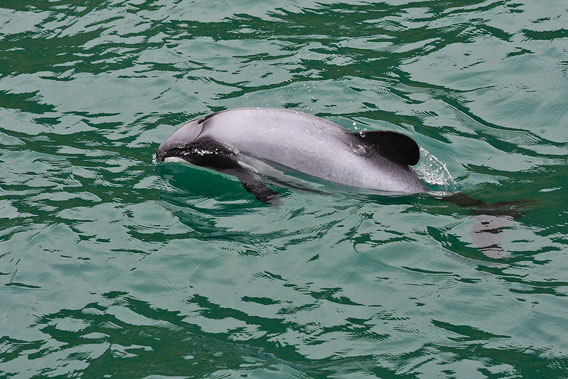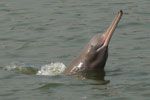
Hector’s dolphin is the parent species of the subspecies Maui’s dolphin. Both are only found in New Zealand. Photo by: Bigstock.
The world’s smallest dolphin is also the closest to extinction. New Zealand government figures show that Maui’s dolphin (Cephalorhynchus hectori maui) are down to just 55 mature individuals, falling from 111 in 2005. The small cetaceans, measuring up to 1.7 meters (5.5 feet), are imperiled due to drowning in gillnets with the most recent death by a fisherman’s net occurring in January.
“These latest population figures show we have to act now, there is no choice. Any delay could lead to more deaths of Maui’s dolphins in fishing nets and tip the species past the point of no return,” Katrina Subedar with New Zealand NGO, Forest and Bird, said in a press release.
The conservation group is calling for immediate safeguards for Maui’s dolphin while the government discusses long-term actions. They say the Primary Industries Minister should use emergency powers to ban gillnets and trawlers in Maui’s dolphins habitat.
With 55 mature Maui’s dolphins left, researchers believe only 20 may be female. Maui’s dolphins are slow breeders: they take around seven years to breed and then only reproduce every few years.
“We can’t change our past to bring back species like the moa that are lost forever, but we must not, and will not, give up on our critically endangered dolphins,” Rebecca Bird, WWF-New Zealand’s Marine Program Manager, recently said. “We know that solutions exist to save Maui’s, it is time the government acted on behalf of all New Zealanders to protect this precious national treasure.”
Maui’s dolphins are a subspecies of Hector’s dolphin (Cephalorhynchus hectori), which is listed as Endangered by the IUCN Red List. Like Maui’s dolphin, the major threat to Hector’s is the use of gillnets. Both are found only in the seas surrounding New Zealand.
A petition on the issue has been started on Avaaz: Save the Maui’s Dolphin.
Related articles
Featured video: scientists capture first footage of Shepherd’s beaked whale
(02/27/2012) Scientists have captured what is believed to be the world’s first footage of the cryptic Shepherd’s beaked whale (Tasmacetus shepherdi), one of a number of beaked whale species about which scientists know almost nothing.
Amazon.com stops selling whale meat
(02/22/2012) Amazon Japan, a subsidiary of Amazon.com, pulled all whale meat products (and possibly dolphin meat) from its site after a new report by the Environmental Investigation Agency (EIA) and the Humane Society International highlighted the issue. Last December the organizations recorded 147 whale products on sale at Amazon Japan despite an international whaling moratorium since 1986. Japan, along with Iceland and Norway, continues to industrially hunt whales. Japan says their whale hunt is for scientific purposes only, but environmentalists dispute this.
New sanctuaries declared for Asia’s freshwater dolphins

(02/15/2012) Bangladesh has declared three new sanctuaries to help protect the south Asian river dolphin (Platanista gangetica) in the Sundarbans, the world’s largest mangrove forest. Split into two subspecies, the Ganges River dolphin (Platanista gangetica gangetica) and the Irrawaddy River dolphin (Platanista gangetica minor), the new sanctuaries will benefit both. Listed as Endangered by the IUCN Red List, the south Asian freshwater dolphin has disappeared from much of its habitat. Already Asia has its other freshwater dolphin species: the baiji (Lipotes vexillifer) was declared functionally extinct into 2006 after a survey of the Yangtze River failed to find a single individual.
87 marine mammals still eaten by people
(01/24/2012) Threats to marine mammals usually include climate change, drowning as by-catch, pollution, depletion of prey, but what about eating marine mammals? A new study in Biological Conservation finds that a surprising 87 marine mammals—including polar bears, small whales, and dolphins—have been eaten as food since 1990 in at least 114 countries.
Featured video: tuna industry bycatch includes sea turtles, dolphins, whales
(01/16/2012) A Greenpeace video, using footage from a whistleblower, shows disturbing images of the tuna industry operating in the unregulated waters of the Pacific Ocean. Using fish aggregation devices (FADs) and purse seine nets, the industry is not only able to catch entire schools of tuna, including juvenile, but also whatever else is in the area of the net.